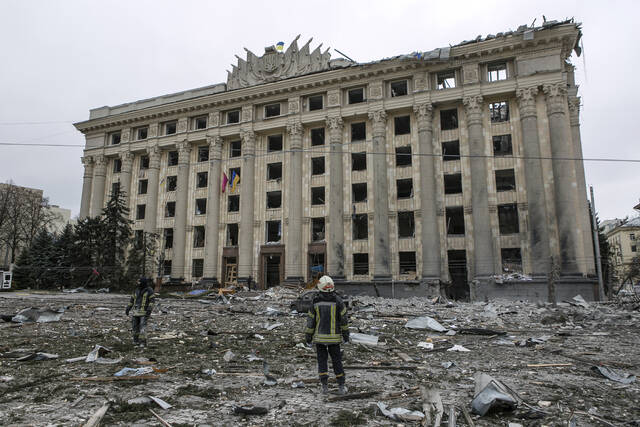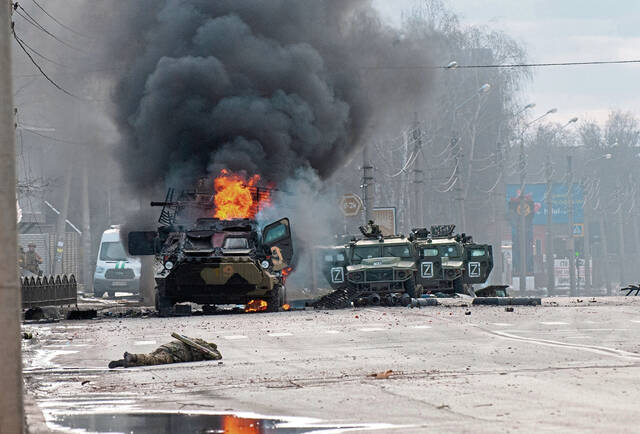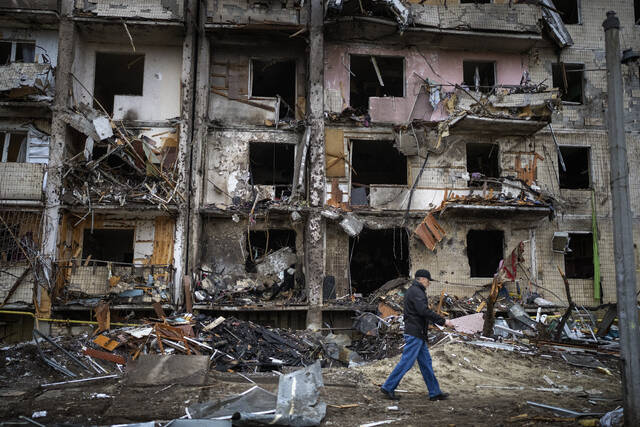Talks at home, school can help children process Ukraine war images, information
Russia’s invasion of Ukraine has been dubbed the TikTok war by some, as videos of the violence have surfaced across that and other social media platforms favored by many of today’s youths.
“It makes it more real for them, not just some distant event,” said Jaime Rininger, who teaches geography and civics to seventh graders at Jeannette City School District. “Students have access to videos and images from the front lines that weren’t there in previous conflicts.”
Whereas their parents’ generation largely watched the Gulf War play out three decades ago through wall-to-wall coverage on CNN and other cable news networks, TikTok and Instagram have brought the conflict front and center to a different generation that might otherwise have been ignorant to the atrocities.
That footage and imagery also is raising anxieties and questions in homes and schools about what’s unfolding: Where is that? Why is this happening? Could this happen here?
Rininger answers students’ questions when she is able but said she is “honest when I don’t really know the answer.”
She also tries to calm any fears her pupils may express.
“There is some anxiety about the situation for some of my students,” she said. “Much of what they are asking is if it will lead to world war. ‘How is this going to affect us? Will we be bombed?’”
Michelle Dickerson, a Highlands High School social studies teacher, said the district’s approach to what is happening in Ukraine has been conversational between teachers and students.
“Government class students have discussed what the United States can do as part of NATO and how foreign policy works,” she said. “They have also discussed executive and legislative powers and what the president can do versus what needs congressional approval.”
In economics class at Highlands, there have been talks about the purpose and potential effects of sanctions and the role they play in diplomacy and foreign policy. In American history classes, there have been comparisons to World War I and the issues that spurred that conflict versus today’s issues.
World War I was spurred by the destruction of the middle class in Germany and the assassination of Archduke Franz Ferdinand, heir to the throne of Austria-Hungary.
Dickerson said she teaches several electives in which the invasion of Ukraine is relevant, including Modern America, Holocaust and Genocide Studies, and AP European History.
“The day of the invasion, I spent the majority of the class period on the topic in all of my courses,” she said. “Since then, I have started each period by giving students brief updates using information from various news outlets.
“Students have asked a lot of questions about the creation and purpose of NATO and why Russia is against NATO expansion in Eastern Europe. They have also been interested in how the situation is creating refugees in Ukraine and have asked a lot of questions about how people leave their home during times of war and crisis.”
She said many students have begun following various Twitter and TikTok feeds based in Ukraine.
In Leechburg Area School District, American History teacher Scott Hooks said class discussions have been informal, with students expressing interest about the events in Europe.
“My students, on the whole, are informed about the war but have had questions,” Hooks said. “Many of the common student questions are about what sparked the conflict between Russia and Ukraine and the responses of the United States to actions taken by Russia.”
If anxieties arise, the most important way adults can respond is to acknowledge a child’s feelings, said Amy Alexander, school counselor for more than 15 years at Penn Hills High School.
A former social studies teacher, Alexander said students have been exposed to unrest since the beginning of the covid-19 pandemic.
“I don’t think the trauma is different in what they’ve seen with social unrest in the streets of America or the isolation of covid,” she said.
“The conflict in Ukraine may seem distant, but the world is getting smaller with social media, and caring adults need to acknowledge children’s feelings.”
Trauma is not limited by geographical distance, Alexander said.
“There’s awareness of the conflict, and it affects them,” she said.
“Kids can relate to the fact that people are fleeing from their homes and that feeling of unsettledness.”
Kimberly Clinebell, UPMC clinical assistant professor of psychiatry, said first finding out what a child’s specific concern is and then validating a child’s feelings is vital.
“Answering a child’s questions, if you are able to answer them, can also help to alleviate anxiety,” Clinebell said.
“If feeling anxious about social media news feeds/Twitter/TikTok, I recommend limiting exposure to this. Younger children should have less exposure to these things in general, but families may need to consciously make an effort to turn off the news and limit exposure to social media if a child or family member is particularly anxious about current events.”
Adults can help by simply being present and listening, said Maureen Ritson, a Latrobe-based therapist with Excela Health’s Child and Adolescent Inpatient Behavioral Health Services.
“Having the ability to talk and express your feelings is so helpful for kids,” Ritson said.
Parents should offer reassurance to children who express concern about the war while remaining alert to signs that they may need additional help to cope with anxieties and stress, Ritson said.
“As a parent, you really need to be attuned to your kids’ behaviors and how they’re acting,” she said. “If you see changes in their typical behavior, that’s a red flag.”
Problems sleeping is one of those warning signs, she said.
Older children may benefit from gaining knowledge about the situation in Ukraine and its broader ramifications, providing context to what they may be exposed to through social media. “Knowledge is power,” Ritson said.
But, she said, that may not be a good idea for younger children whose perception of the war otherwise would be minimal or nonexistent.
“Unless they bring it up, they’ve had so many other stresses with covid and online schooling,” she said.
Ritson suggested several avenues, including going for a walk, that children can pursue to help alleviate stress they may feel.
“We continue to encourage healthy coping by getting involved in school activities and clubs,” she said. “Athletics and art are excellent outlets for kids.”
If they’re so inclined, she noted, children also might consider getting involved in charitable efforts to assist Ukrainians who are in need.
At Greensburg Salem School District, social studies faculty have engaged in informal discussions with students about the invasion.
“Students are coming to class with questions about what they see on social media,” Superintendent Ken Bissell said. “Teachers are providing students with time to talk about the situation and helping them make sense of the topic based on current and historical references.”
“Most of what we have covered on Ukraine has been informal discussions,” said Bob Lehman, who teaches a course in international studies for juniors at Greensburg Salem High School. “Things happen so quickly that it is often difficult to keep up.”
Nathan Forbes, who teaches world history and general law at Jeannette’s high school, noted many students have drawn parallels between the current situation in Ukraine and past conflicts among nations. Coincidentally, he said, a history club he advises completed a discussion of the 1979 Soviet invasion of Afghanistan shortly before Russian troops began their advance into Ukraine.
Forbes said he cautions his students about fearmongering that can occur but added, “By no means do I want to diminish what is happening in Ukraine and the possibility of escalation.”
His students are turning to studies of peace efforts in the Middle East. But when it comes to periodic discussions of current events, he said, “Something tells me Ukraine is going to monopolize those for the remainder of the school year.”
Jeff Himler and Tawnya Panizzi are Tribune-Review staff writers. You can contact Jeff at 724-836-6622, jhimler@triblive.com or via Twitter @jhimler_news. You can contact Tawnya at 724-226-7726, tpanizzi@triblive.com or via Twitter @tawnyatrib.
Remove the ads from your TribLIVE reading experience but still support the journalists who create the content with TribLIVE Ad-Free.




